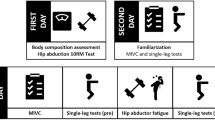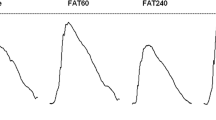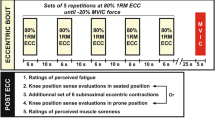Abstract
Purpose
Fatigue in one limb can decrease force production in the homologous muscle as well as other muscles of the non-fatigued limb affecting balance. The objective of the study was to examine the effect of unilateral knee extensor fatigue on the non-fatigued limb’s standing balance, muscle force and activation.
Method
Sixteen healthy male subjects performed pre-fatigue balance trials, warm-up exercises, maximum voluntary isometric contractions, a knee extensors fatigue protocol, and post-fatigue balance trials. The fatigue protocol consisted of sets of 15 consecutive isometric contractions of 16 s each with 4 s recovery between repetitions, which were performed at 30 % peak force for the dominant knee extensor muscles. Additional sets of contractions continued until a 50 % decrease in MVIC knee extensor force was observed. Pre- and post-fatigue balance assessment consisted of transition from double to single leg standing and also single leg standing trials, which were performed bilaterally and in randomized order.
Result
The peak force and F100 were significantly decreased by 44.8 % (ES = 2.54) and 39.9 % (ES = 0.59), respectively, for the fatigued limb post-fatigue. There were no significant changes in the non-fatigued limb’s muscle force, activation, muscle onset timing or postural stability parameters.
Conclusion
While the lack of change in non-fatigued limb force production is in agreement with some of the previous literature in this area, the lack of effect on postural measures directly contradicts earlier work. It is hypothesized that discrepancies in the duration and the intensity of the fatigue protocol may have accounted for this discrepancy.





Similar content being viewed by others
Abbreviations
- AP:
-
Antero-posterior
- CNS:
-
Central nervous system
- CoP:
-
Center of pressure
- EMG:
-
Electromyography
- ES:
-
Effect size
- GM:
-
Gastrocnemius medialis
- Gmax:
-
Gluteus maximus
- Gmed:
-
Gluteus medius
- GRF:
-
Ground reaction force
- Hz:
-
Hertz
- ML:
-
Medio-lateral
- MVIC:
-
Maximal voluntary isometric contraction
- PL:
-
Peroneus longus
- RMS:
-
Root mean square
- SD:
-
Standard deviation
- TA:
-
Tibialis anterior
- VL:
-
Vastus lateralis
- VM:
-
Vastus medialis
References
Amann M, Venturelli M, Ives SJ (2013) Peripheral fatigue limits endurance exercise via a sensory feedback-mediated reduction in spinal motoneuronal output. J Appl Physiol 115:355–364
Behm DG, St-Pierre DM (1997) Effects of fatigue duration and muscle type on voluntary and evoked contractile properties. J Appl Physiol 82:1654–1661
Behm DG, Button DC, Butt JC (2001) Factors affecting force loss with prolonged stretching. Can J Appl Physiol 26:261–272
Behm D, Bambury A, Cahill F, Power K (2004) The effect of acute static stretching on force, balance, reaction time and movement time. Med Sci Sports Exerc 36(8):1397–1402
Bellew JW, Fenter PC (2006) Control of balance differs after knee or ankle fatigue in older women. Arch Phys Med Rehabil 87:1486–1489
Bigelow KE (2008) Identification of key traditional and fractal postural sway parameters to develop a clinical protocol for fall risk assessment in older adults. Dissertation, Ohio State University
Bigland-Ritchie B, Woods JJ (1984) Changes in muscle contractile properties and neural control during human muscular fatigue. Muscle Nerve 7:691–699
Bigland-Ritchie B, Cafarelli E, Vollestad NK (1986) Fatigue of submaximal static contractions. Acta Physiol Scand Suppl 556:137–148
Bolton DA, McIlroy WE, Staines WR (2011) The impact of light fingertip touch on haptic cortical processing during a standing balance task. Exp Brain Res 212:279–291
Burden AM, Trew M, Baltzopoulos V (2003) Normalization of gait EMGs: a re-examination. J Electromy Kinesiol 13(6):519–532
Button DC, Behm DG (2008) The Effect of Stimulus Anticipation on the Interpolated Twitch Technique. J Sport Sci Med 7:520–524
Cohen J (1969) Statistical power analysis for the biomechanical sciences. L. Erbraum Associates, New York, USA
Cohen J (1990) Things I have learned (so far). Am Psych 45:1304–1312
Criswell E (2011) Cram’s introduction to surface electromyography. Jones and Bartlett Publishers, USA
De Luca CJ, Gilmore LD, Kuznetsov M (2010) Filtering the surface EMG signal: movement artifact and baseline noise contamination. J Biomech 43:1573–1579
Dibble LE, Lopez-Lennon C, Lake W et al (2013) Utility of disease-specific measures and clinical balance tests in prediction of falls in persons with multiple sclerosis. J Neuro Phys Ther 37:99–104
Duarte M, Zatsiorsky VM (2002) Effects of body lean and visual information on the equilibrium maintenance during stance. Exp Brain Res 146:60–69
Elmer SJ, Amann M, McDaniel J et al (2013) Fatigue is specific to working muscles: no crossover with single-leg cycling in trained cyclists. Eur J Appl Physiol 113:479–488
Enoka RM, Duchateau J (2008) Muscle fatigue: what, why and how it influences muscle function. J Physiol 586:11–23
Grabiner MD, Owings TM (1999) Effects of eccentrically and concentrically induced unilateral fatigue on the involved and uninvolved limbs. J Electromyogr Kinesiol 9:185–189
Graven-Nielsen T, Lund H, Arendt-Nielsen L (2002) Inhibition of maximal voluntary contraction force by experimental muscle pain: a centrally mediated mechanism. Muscle Nerve 26:708–712
Gribble PA, Hertel J (2004) Effect of lower-extremity muscle fatigue on postural control. Arch Phys Med Rehabil 85:589–592
Halperin I, Copithorne D, Behm DG (2014a) Unilateral isometric muscle fatigue decreases force production and activation of contralateral knee extensors but not elbow flexors. Appl Physiol Nutr Metab 39:1338–1344
Halperin I, Aboodarda SJ, Behm DG (2014b) Knee extension fatigue attenuates repeated force production of the elbow flexors. Eur J Sport Sci 14:823–829
Hertel J (2000) Functional instability following lateral ankle sprain. Sports Med 29:361–371
Hodges PW, Bui BH (1996) A comparison of computer-based methods for the determination of onset of muscle contraction using electromyography. Electroencephalogr Clin Neurophysiol 101:511–519
Humphry AT, Lloyd-Davies EJ, Teare RJ et al (2004) Specificity and functional impact of post-exercise depression of cortically evoked motor potentials in man. Eur J Appl Physiol 92:211–218
Kanekar N, Santos MJ, Aruin AS (2008) Anticipatory postural control following fatigue of postural and focal muscles. Clin Neurophysiol 119:2304–2313
Kawamoto JE, Aboodarda SJ, Behm DG (2014) Effect of differing intensities of fatiguing dynamic contractions on contralateral homologous muscle performance. J Sports Sci Med 13:836–845
Kennedy A, Hug F, Sveistrup H (2013) Fatiguing handgrip exercise alters maximal force-generating capacity of plantar-flexors. Eur J Appl Physiol 113:559–566
Kibele A, Behm DG (2009) Seven weeks of instability and traditional resistance training effects on strength, balance and functional performance. J Strength Cond Res 23(9):2443–2450. doi:10.1519/JSC.0b013e3181bf0328
MacDonald GZ, Button DC, Drinkwater EJ, Behm DG (2014) Foam rolling as a recovery tool following an intense bout of physical activity. Med Sci Sports Exerc 46:131–142
Macefield G, Gandevia SC, Burke D (1990) Perceptual responses to microstimulation of single afferents innervating joints, muscles and skin of the human hand. J Physiol 429:113–129
Martin PG, Rattey J (2007) Central fatigue explains sex differences in muscle fatigue and contralateral crossover effects of maximal contractions. Pflugers Arch 454:957–969
Masani K, Sayenko DG, Vette AH (2013) What triggers the continuous muscle activity during upright standing? Gait Posture 37:72–77
McLean SG, Samorezov JE (2009) Fatigue-induced ACL injury risk stems from a degradation in central control. Med Sci Sports Exerc 41:1661–1672
Paillard T, Chaubet V, Maitre J et al (2010) Disturbance of contralateral unipedal postural control after stimulated and voluntary contractions of the ipsilateral limb. Neurosci Res 68:301–306
Penney T, Ploughman M, Behm DG, Byrne JM (2014) Determining the activation of gluteus medius and the validity of the single leg stance test in chronic non-specific low back pain. Arch Physical Med Rehab 95:1969–1976
Place N, Lepers R, Deley G (2004) Time course of neuromuscular alterations during a prolonged running exercise. Med Sci Sports Exerc 36:1347–1356
Place N, Duclay J, Lepers R, Martin A (2009) Unchanged H-reflex during a sustained isometric submaximal plantar flexion performed with an EMG biofeedback. J Electromyogr Kinesiol. 19:e395–e402
Post M, Bayrak S, Kernell D et al (2008) Contralateral muscle activity and fatigue in the human first dorsal interosseous muscle. J Appl Physiol 105:70–82
Rattey J, Martin PG, Kay D et al (2006) Contralateral muscle fatigue in human quadriceps muscle: evidence for a centrally mediated fatigue response and cross-over effect. Pflugers Arch 452:199–207
Regueme SC, Barthelemy J, Nicol C (2007) Exhaustive stretch-shortening cycle exercise: no contralateral effects on muscle activity in maximal motor performances. Scand J Med Sci Sports 17:547–555
Robertson DGE, Caldwell GE, Hamill J et al (2004) Research methods for biomechanics. Human Kinetics Publishers, Champaign III USA
Ross EZ, Middleton N, Shave R et al (2007) Corticomotor excitability contributes to neuromuscular fatigue following marathon running in man. Exp Physiol 92:417–426
Ross EZ, Goodall S, Stevens A et al (2010) Time course of neuromuscular changes during running in well-trained subjects. Med Sci Sports Exerc 42:1184–1190
Schoneburg B, Mancini M, Horak F et al (2013) Framework for understanding balance dysfunction in Parkinson’s disease. Mov Disord 28:1474–1482
Sims KJ, Brauer SG (2000) A rapid upward step challenges medio-lateral postural stability. Gait Posture 12:217–224
Strang AJ, Berg WP, Hieronymus M (2009) Fatigue-induced early onset of anticipatory postural adjustments in non-fatigued muscles: support for a centrally mediated adaptation. Exp Brain Res 197:245–254
Takahashi K, Maruyama A, Hirakoba K et al (2011) Fatiguing intermittent lower limb exercise influences corticospinal and corticocortical excitability in the non-exercised upper limb. Brain Stimul 4:90–96
Taylor JL, Todd G, Gandevia SC (2006) Evidence for a supraspinal contribution to human muscle fatigue. Clin Exp Pharmacol Physiol 33:400–405
Todd G, Petersen NT, Taylor JL et al (2003) The effect of a contralateral contraction on maximal voluntary activation and central fatigue in elbow flexor muscles. Exp Brain Res 150:308–313
Triscott S, Gordon J, Kuppuswamy A et al (2008) Differential effects of endurance and resistance training on central fatigue. J Sports Sci 26:941–951
Vellas BJ, Wayne SJ, Romero L et al (1997) One-leg balance is an important predictor of injurious falls in older persons. J Am Geriatr Soc 45:735–738
Yaggie J, Armstrong WJ (2004) Effects of lower extremity fatigue on indices of balance. J Sport Rehabil 13:312–322
Zijdewind I, Zwarts MJ, Kernell D (1998) Influence of a voluntary fatigue test on the contralateral homologous muscle in humans? Neurosci Lett 253:41–44
Acknowledgments
This study was partially funded by the Natural Science and Engineering Research Council (NSERC) of Canada. We thank Dr. Thamir Alkanani for his technical support and the subjects for their enthusiastic cooperation.
Conflict of interest
None of the authors have a conflict of interest.
Author information
Authors and Affiliations
Corresponding author
Additional information
Communicated by Fausto Baldissera.
Rights and permissions
About this article
Cite this article
Arora, S., Budden, S., Byrne, J.M. et al. Effect of unilateral knee extensor fatigue on force and balance of the contralateral limb. Eur J Appl Physiol 115, 2177–2187 (2015). https://doi.org/10.1007/s00421-015-3198-5
Received:
Accepted:
Published:
Issue Date:
DOI: https://doi.org/10.1007/s00421-015-3198-5




